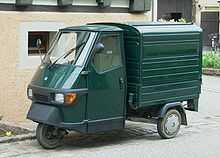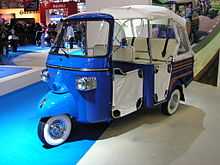Piaggio Ape
 | |
| Overview | |
|---|---|
| Manufacturer | Piaggio |
| Production | 1948-present |
| Assembly | Pune, India |
| Designer | Piaggio |
| Body and chassis | |
| Class | Submicro Van |
| Body style | Van, Pickup, Autorickshaw |
| Platform | Vs67MP5 |
The Piaggio Ape ([ˈpjaddʒo ˈaːpe]; AH-pay;[1] Italian for bee[2]), sometimes referred to as Ape Piaggio, Apecar, Ape Car or just Ape, is a three-wheeled light commercial vehicle first produced in 1948 by Piaggio.
History and design
At the end of World War II, most Italians, badly affected by the war, lacked means of transport and, more importantly, the financial means to acquire and maintain full-sized four-wheeled vehicles. In 1947, the inventor of the Vespa, aircraft designer Corradino D'Ascanio, came up with the idea of building a light three-wheeled commercial vehicle to power Italy's economical reconstruction, an idea which found favour with Enrico Piaggio, the son of the firm's founder, Rinaldo. The very first Ape model and the mark immediately following it were mechanically a Vespa with two wheels added to the rear, with a flat-bed structure on top of the rear axle. The early sales brochures and adverts referred to the vehicle as the VespaCar or TriVespa. The first Apes featured 50 cc,[3] 125 cc or 150 cc and more recently 175 cc engines. By the time of the 1964 Ape D, a cab was added to protect the driver from the elements.[4] The Ape has been in continuous production since its inception and has been produced in a variety of different body styles in Italy and India.

Controlled with scooter style handlebars (current TM version could be bought also with steering wheel), the original Ape was designed to seat one, but can accommodate a passenger (with a tight fit) in its cab. A door is provided on each side, making it quicker to get out of the vehicle when making deliveries to different sides of the road. Performance is suited to the job of light delivery, with good torque for hills but a low top speed, which is irrelevant in the urban settings for which it was designed. Outside of towns, Apes are customarily driven as close as possible to the curb to allow traffic to pass.



Usage
The vehicles come in various configurations such as vans and pickups for load carrying (popular with postal administration in some countries) and an autorickshaw (Tuk-tuk) for human transportation. More recently Piaggio have made lifestyle models such as the Ape Cross Country and the Ape Web aimed at the young. The Ape is also commonly used as a promotion tool. Advertising hoardings are mounted in the load bay. The Ape's unusual looks can help draw attention to a brand or business.
The Ape is still not an uncommon sight in Italy where its compact size allows it to negotiate narrow city streets and park virtually anywhere. In small southern villages, it is also often seen at the roadside where the load area is used as an impromptu market stall by farmers.
Most Apes are produced in India by Piaggio India, and a similar vehicle is manufactured by Bajaj Auto. In India the Ape is most commonly found in the form of an autorickshaw (or tuk-tuk). A relatively small number of Apes is still made in Italy. On October 16, 2013, Piaggio announced that the production of Ape would be completely shut down in Italy and entirely moved to India.[5]
Nowadays two model ranges are offered: the "Ape 50" with a 49.8 cc petrol engine[6] and the larger "Ape TM" which comes available with a 218 cc petrol engine or a 422 cc diesel engine.[7] The "Ape 50" can carry 175 to 205 kg (386 to 452 lb) while the "TM" and "Classic" can carry 700 to 805 kg (1,543 to 1,775 lb) (depending on version and engine).[8] Fuel consumption for the current Ape 50 model is about 30 km/l (85 mpg-imp; 71 mpg-US)[9][10] A limited edition named the Calessino was made available: this had retro styling and came in an autorickshaw body. The bodywork was close to the Ape of the 1950s and 1960s and was designed to evoke memories of the era of dramatic economic growth in Italy known as Miracolo Economico.[11]
Model history and descriptions
- 1948–1952 - Ape A: 125 cc engine, wooden pick up bed, front fork mounted to the left of the wheel hub and column mounted gear lever.
- 1952–1956 - Ape B: similar to the A model but with a 150 cc engine, a pressed steel cargo bed, front fork mounted to the right of the wheel hub and cable operated gearchange.
- 1956–1967 - Ape C: Still sporting a 150 cc engine but with a major redesign: the first Ape with an enclosed cab, the engine uses a 5% oil mix and is sited under the driver's seat. It was still manually started, but electric start was optional.
- 1964–1967 - Ape D: 175cc engine. Featured a trapezoidal headlight fitted on the bulkhead rather than the mudguard and an intake valve that allowed the engine to run with a 2% oil mix. The first Ape with cab heater.
- 1965–1973 - Ape E: Identical to the D model but with a 150 cc engine.
- 1968–1978 - Ape MP: MP stood for Motore Posteriore (Rear Engine), the engine was moved from the cab to the rear to improve comfort.
- 1970–1978 - Ape E/400R: 175 cc engine and minor changes.
- 1979–1981 - Ape P: 175 cc, with minor changes.
- 1981–1993 - Ape 500: 175 cc, new front with two headlights on each side.
- 1994–1999 - Ape Web & Ape Cross: 49.8 cc engine, redesigned front and rear headlights, roll-bar.
- since 1982 - Ape TM: 218 cc petrol and 422 cc diesel variants. Available with handlebar or steering-wheel. Maximum speed for the petrol version is 60 km/h, 63 km/h for the diesel version.[12]
- since 1996 - Ape 50: 49.8 cc, redesign of the headlights incorporating side lights.
- since 1996 - Ape Furgone 50: van version of the Ape 50.
- since 2000 - Ape Cross Country 50: sport-look restyling of preceding Ape 50.
- since 2006 - Ape Classic: built also in India with a Lombardini 422 cc Diesel engine.
Special variants
- 1960–1968 - Ape Pentarò: standard Ape with a semi-trailer.[13]
- 1993–2005 - Ape Poker: four-wheel version of the Ape TM, with the same engine.
Gallery
-

Ape A
-

Ape C
-

Ape Cross Country
-

Ape Poker
-

Ape 50 used as a garbage truck
-
-

-

1977 Apecar LS
References
Model descriptions translated from Italian Wikipedia.
- ↑ "Auto Motor Sport - Piaggio Ape 50". apepiaggio. youtube.com. Retrieved 30 January 2013.
- ↑ "Piaggio Ape". 3wheelers.com. Retrieved 2006-07-16.
- ↑ "Piaggio Ape Commercial Vehicle". Greencarsite.co.uk. Retrieved 2013-02-17.
- ↑ http://www.piaggio-ape.co.uk/
- ↑ "Veicoli commerciali, dopo 65 anni Piaggio sospende la produzione italiana dell’Ape". www.ilfattoquotidiano.it. 2013-11-01. Retrieved 2013-11-01.
- ↑ http://www.piaggio-ape.co.uk/ape50panelvan.htm
- ↑ "Performances" http://www.piaggio-ape.co.uk/apetmpanelvan.htm
- ↑ "APE brochure". http://www.piaggiocommercialvehicles.com. Retrieved 30 January 2013.
- ↑ "Meet the Ape from Piaggio". irishtrucker.com. Retrieved 30 January 2013.
- ↑ "Piaggio Ape: Not quite planet of the Apes". independent.co.uk. Retrieved 30 January 2013.
- ↑ "Piaggio Ape Calessino - Limited Edition". Piaggioape.co.uk. 2010-11-02. Retrieved 2013-02-17.
- ↑ http://www.piaggioape.co.uk/downloads/Ape%20TM%20Pick%20Up.pdf
- ↑ "Curbside Classic: 2002 Piaggio Ape 50 – It's Pronounced Ah-Peh". curbsideclassic.com. Retrieved 30 January 2013.
External links
| Wikimedia Commons has media related to Piaggio Ape. |
